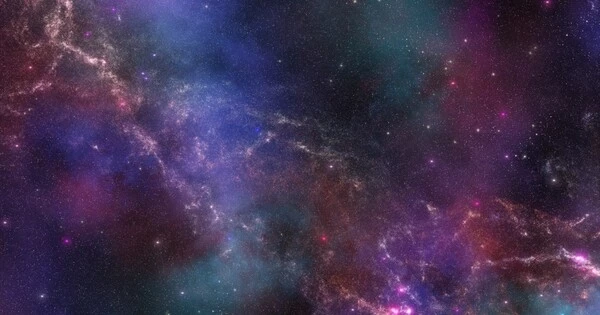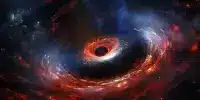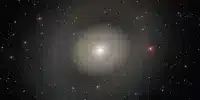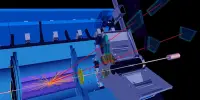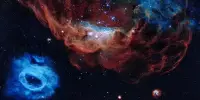A team of astronomers has developed a method for detecting light from the first stars and galaxies through the fog of the early Universe. The researchers, led by the University of Cambridge, have devised a method for observing and studying the first stars through the clouds of hydrogen that filled the Universe about 378,000 years after the Big Bang.
Observing the birth of the first stars and galaxies has long been a goal of astronomers, as it will help explain how the Universe evolved from the void following the Big Bang to the complex realm of celestial objects we see today, 13.8 billion years later.
The Square Kilometre Array (SKA), a next-generation telescope expected to be completed by the end of the decade, will most likely be able to make images of the Universe’s earliest light, but the challenge for current telescopes is detecting the cosmological signal of the stars through the thick hydrogen clouds.
The signal that astronomers hope to detect is expected to be one hundred thousand times weaker than other radio signals from the sky, such as radio signals from our own galaxy. Using a radio telescope itself introduces distortions to the signal received, which can completely obscure the cosmological signal of interest. This is considered an extreme observational challenge in modern radio cosmology. Such instrument-related distortions are commonly blamed as the major bottleneck in this type of observation.
The Cambridge-led team has now developed a method for seeing through primordial clouds and other sky noise signals while avoiding the negative effects of radio telescope distortions. Their methodology, which is part of the REACH (Radio Experiment for the Analysis of Cosmic Hydrogen) experiment, will allow astronomers to observe the first stars by observing their interactions with hydrogen clouds, much like we would infer a landscape by looking at shadows in the fog.
Due to the temperature of the hydrogen gas, which should be much cooler than our current understanding of the Universe would allow, the original result would necessitate new physics to explain it.
de Lera Acedo
Their method will improve the quality and reliability of radio telescope observations during this previously unexplored critical period in the evolution of the Universe. The first REACH observations are expected later this year.
The results are reported today in the journal Nature Astronomy.
“At the time when the first stars formed, the Universe was mostly empty and composed mostly of hydrogen and helium,” said Dr Eloy de Lera Acedo from Cambridge’s Cavendish Laboratory, the paper’s lead author.
He added: “Because of gravity, the elements eventually came together and the conditions were right for nuclear fusion, which is what formed the first stars. But they were surrounded by clouds of so-called neutral hydrogen, which absorb light really well, so it’s hard to detect or observe the light behind the clouds directly.”
Another research group (running the ‘Experiment to Detect the Global Epoch of Reioniozation Signature’ — or EDGES — published a result in 2018 that hinted at a possible detection of this earliest light, but astronomers have been unable to replicate the result, leading them to believe that the original result was due to interference from the telescope being used.
“Due to the temperature of the hydrogen gas, which should be much cooler than our current understanding of the Universe would allow, the original result would necessitate new physics to explain it. Alternatively, an unexplained increase in the temperature of the background radiation — typically assumed to be the well-known Cosmic Microwave Background — could be the cause” said de Lera Acedo.
He added: “If we can confirm that the signal found in that earlier experiment really was from the first stars, the implications would be huge.”
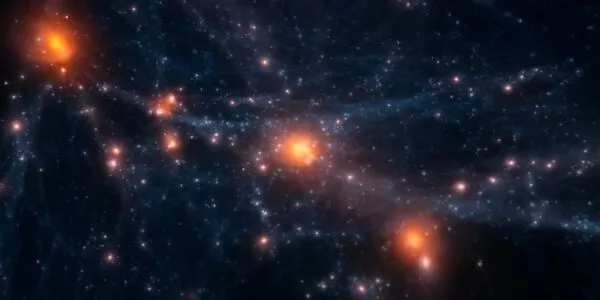
In order to study this period in the Universe’s development, often referred to as the Cosmic Dawn, astronomers study the 21-centimetre line — an electromagnetic radiation signature from hydrogen in the early Universe. They look for a radio signal that measures the contrast between the radiation from the hydrogen and the radiation behind the hydrogen fog.
The methodology developed by de Lera Acedo and his colleagues uses Bayesian statistics to detect a cosmological signal in the presence of interference from the telescope and general noise from the sky, so that the signals can be separated.
To do this, state-of-the-art techniques and technologies from different fields have been required.
The researchers used simulations to mimic a real observation using multiple antennas, which improves the reliability of the data — earlier observations have relied on a single antenna.
“Our method jointly analyses data from multiple antennas and across a wider frequency band than equivalent current instruments. This approach will give us the necessary information for our Bayesian data analysis,” said de Lera Acedo.
He continued: “In essence, we abandoned traditional design strategies in favor of creating a telescope tailored to the way we intend to analyze the data – something akin to an inverse design. This could help us measure things from the Cosmic Dawn to the epoch of reionisation, when the Universe’s hydrogen was re-ionised.”
The construction of the telescope is currently being completed at the Karoo radio reserve in South Africa, which was chosen for its excellent conditions for radio observations of the sky. It is far away from radio frequency interference caused by humans, such as television and FM radio signals.
The REACH team of over 30 researchers is multidisciplinary and distributed worldwide, with experts in fields such as theoretical and observational cosmology, antenna design, radio frequency instrumentation, numerical modelling, digital processing, big data and Bayesian statistics. REACH is co-led by the University of Stellenbosch in South Africa.
“Although the antenna technology used for this instrument is rather simple,” said Professor de Villiers of the University of Stellenbosch in South Africa, “the harsh and remote deployment environment, as well as the strict tolerances required in manufacturing, make this a very challenging project to work on.”
Because of studies of the Cosmic Microwave Background (CMB) radiation, the Big Bang and very early times of the Universe are well understood epochs. The late and widespread evolution of stars and other celestial objects is even better understood. However, the time of the formation of the first light in the Cosmos is a critical missing piece in the puzzle of the Universe’s history.
